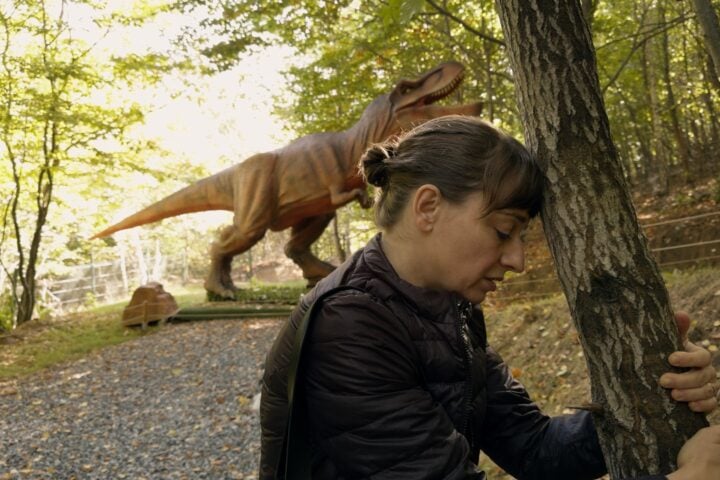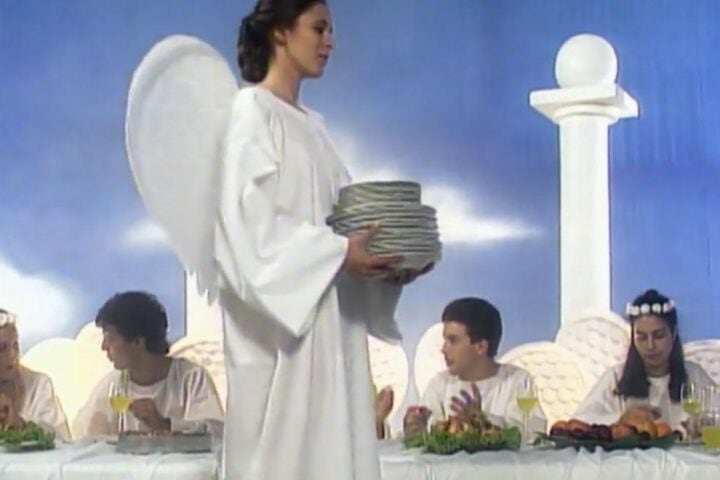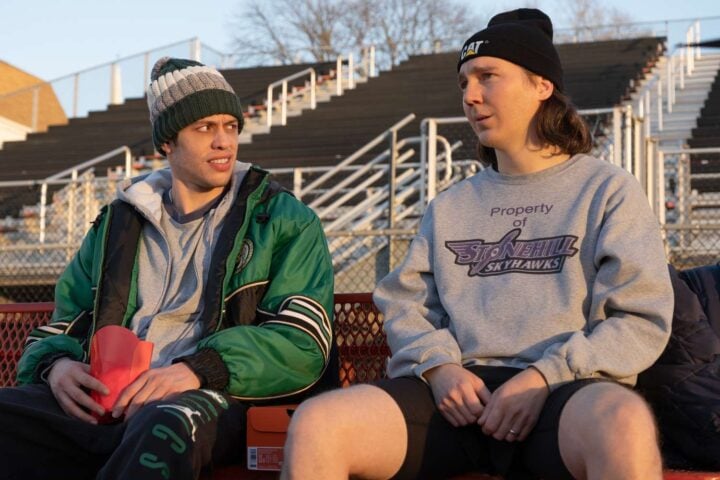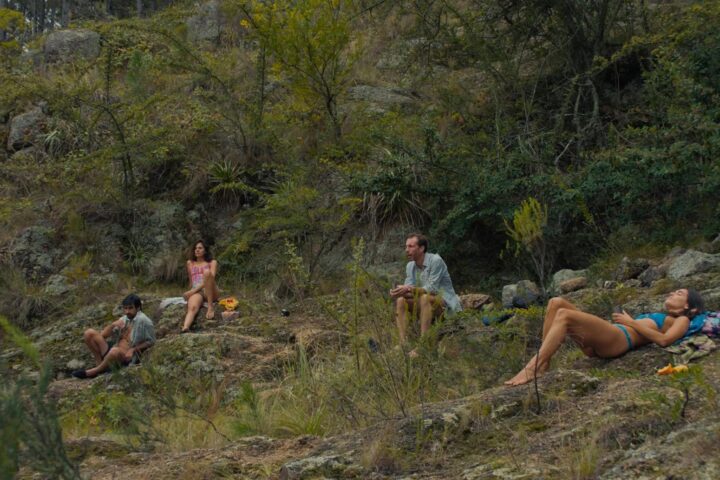For Do Not Expect Too Much from the End of the World, writer-director Radu Jude may have captured more footage from the passenger seat of a car than Abbas Kiarostami’s Taste of Cherry. Cinematographer Marius Panduru, shooting on high-contrast 16mm black-and-white film, renders the traffic-jammed streets of Bucharest as a nightmare vision of modern life. Our guide through this hellscape is Angela (Ilinca Manolache), an overworked and under-slept Uber driver and production assistant. She’s always on the verge of nodding off while driving, and watching cars stream by through the window is a quietly anxious experience.
Angela is conducting at-home auditions with several working-class employees of an Austrian furniture company who were injured on the job. One of the workers will then be selected to appear in a safety advisory video and share their story—or a company-approved version of it—as a cautionary tale slash ass-covering gambit. Angela visits each one in turn and records them on her cellphone, knowing that some, for reasons of ethnic prejudice, are less likely to be chosen than others. (She later explains that while using a Romani woman would show that the company she works for cares about diversity, in Romania this wouldn’t be seen as a good thing.)
The film’s plot, inasmuch as it has one, ultimately hinges on a man left partially paralyzed in a car-related accident, so it’s fair to say that Jude has vehicles on his mind. His camera observes them as economic necessities, environmental hazards, physical dangers, and, perhaps above all, unsightly detritus cluttering modern cities, embodiments of our dependence on technology.
Jude interposes Angela’s urban travelogue with scenes from Lucian Bratu’s 1981 film Angela Moves On, which, being made under the censors’ watch during the last decade of Ceaușescu’s rule, presents a sanitized version of a taxi driver’s life. One of the distinguishing features of Jude’s cinema—and the aspect of his artistry that has earned comparisons with Jean-Luc Godard—is his dialectical approach. Whether putting images into conversation with text (archival photographs and diary excerpts in 2017’s The Dead Nation) or with other images (documentary footage versus recreation in the 2018 short The Marshal’s Two Executions), Jude creates meaning through collage and intuitive associations rather than didactic juxtaposition.
But Jude goes even one step further here, radically rupturing the dialectic when Dorina Lazar, who played Angela in Angela Moves On, shows up to reprise her role. In the present day, she’s a relative of the wheelchair-bound worker, Ovidius (Ovidiu Pîrsan), who’s ultimately selected for the safety video. If we read the excerpts from Angela Moves On as the older Angela’s memories—a technique Steven Soderbergh employed when he cut parts of Ken Loach’s 1967 film Poor Cow into The Limey to show a younger Terence Stamp—then the archival footage becomes integrated into the film’s diegesis, rather than serving a purely discursive function. But that would be a bit too simplistic in a film that so aggressively interrogates the distinction between documentary and fiction—or, to put it more directly, the deceptive potential of recorded images.
Throughout the film, using a video filter that makes her look like Andrew Tate’s face painted on a balloon head, Angelica records short TikTok videos in character as Bobita, a foul-mouthed misogynist and Putin fanboy who rails against the “sluts and whores” of Bucharest. Angelica describes this practice as a critique through exaggeration, and compares herself to the satirical magazine Charlie Hebdo. Treated as a peon at work, she finds perversely comic pleasure in lashing out through her outrageous social media avatar, and even manages to score a cameo from notorious director and boxer Uwe Boll when she visits his set to pick up some lenses.
This theme, of the pliability and manipulative power of images, comes to its climax in Do Not Expect Too Much from the End of the World’s final shot: a 40-minute continuous take comprising the raw footage of the furniture company’s safety video. Ovidius, surrounded by his family, sits in his wheelchair outside the warehouse where he was injured and tells his story. Gradually, as marketing reps step into the shot to coach him into tweaking his account, we see the construction of a false narrative designed to put the company in a favorable light and place responsibility upon the injured party. This process continues until Ovidius is reduced to holding up a series of blank green cards upon which text will be added in post-production.
Long takes in recent Romanian cinema tend to emphasize their duration with static frames, with the director choreographing the actors rather than the camera, and this bravura sequence upholds that tradition, recalling both the shambolic comedy of the television broadcast in 12:08 East of Bucharest and the dreadful inevitability of the town meeting in R.M.N.
If the film sounds like it’s all over the place, it’s because, in marked contrast to Jude’s earlier works, which typically focused on the minutiae of specific historical events or fictional incidents, Do Not Expect Too Much from the End of the World feels like it’s about everything—a shift signaled by the wandering camera pans in Bad Luck Banging or Loony Porn. Jude still taps into a vast archive of literary sources, from Don DeLillo to Slavoj Žižek, all cited in the end credits, conveying the impression of a curious mind making imaginative connections between disparate inputs. But more than that, this is a film that listens avidly to what a cross section of ordinary citizens, played by both actors and non-actors, have to say about the war in Ukraine, Putin, Viktor Orbán, Jewish and Romani people, poverty, exploitation, and any other subject that would come up naturally in the course of visiting people in their homes.
The ample runtime approaching three hours allows for detours and tangents, the most remarkable of which occurs when Angela picks up the Austrian head of marketing, played by Nina Hoss, from the airport. Angela describes a stretch of particularly dangerous highway with hundreds of memorial markers honoring traffic casualties, at which point the film cuts away to a several-minute long silent color montage of the roadside crosses. This elasticity of form accommodates Jude’s impulse to investigate everything, to leave no subject unexplored.
It also speaks to Jude’s tendency to work quickly as a filmmaker—not rushing, but following intuition and putting ideas into immediate action. If this yields work that’s occasionally uneven, it’s also an approach that, film after film, has confirmed Jude as one of the most idiosyncratic, uncompromising, and intellectually vigorous of living filmmakers.
Since 2001, we've brought you uncompromising, candid takes on the world of film, music, television, video games, theater, and more. Independently owned and operated publications like Slant have been hit hard in recent years, but we’re committed to keeping our content free and accessible—meaning no paywalls or fees.
If you like what we do, please consider subscribing to our Patreon or making a donation.





